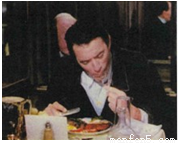题目内容
The Million Pound Bank Note
Act I, Scene 4

(Outside a restaurant Henry looks at the envelope without opening it and decides to go in. He sits down at a table next to the front window.)
OWNER: (seeing Henry's poor appearance) That one's reserved. This way, please. (to the waiter) Take this gentleman's order, Horace.
HENRY: (after sitting down and putting the letter on the table) I'd like some ham and eggs and a nice big steak. Make it extra thick. I'd also like a cup of coffee and a pineapple dessert.
WAITER: Right, sir. I'm afraid it'll cost a large amount of money.
HENRY: I understand. And I'll have a large glass of beer.
WAITER: OK. (The waiter leaves and soon returns with all the food.)
HOSTESS: My goodness! Why, look at him. He eats like a wolf.
OWNER: We'll see if he's clever as a wolf, eh?
HENRY: (having just finished every bit of food) Ah, waiter. (waiter returns) Same thing again, please. Oh, and another beer.
WAITER: Again? Everything?
HENRY: Yes, that's right. (sees the look on the waiter's face) Anything wrong?
WAITER: No, not at all. (to the owner) He's asked for more of the same.
OWNER: Well, it is well-known that Americans like to eat a lot. Well, we'll have to take a chance. Go ahead and let him have it.
WAITER: (reading the bill after the meal) All right. That's two orders of ham and eggs, two extra thick steaks, two large glasses of beer, two cups of coffee and two desserts.
HENRY: (looking at the clock on the wall) Would you mind waiting just a few minutes?
WAITER: (in a rude manner) What's there to wait for?
OWNER: All right, Horace. I'll take care of this.
HENRY: (to owner) That was a wonderful meal. It's amazing how much pleasure you get out of tile simple things in life, especially if you can't have them for a while.
OWNER: Yes, very interesting. Now perhaps, sir, if you pay your bill I can help the other customers.
HENRY: (looking at the clock on the wall again) Well, I see it's two o'clock. (he opens the envelope and holds a million pound bank note in his hands. Henry is surprised but the owner and waiter are shocked) I'm very sorry. But ... I ... I don't have anything smaller.
OWNER: (still shocked and nervous) Well .. er ... just one moment. Maggie, look! (the hostess screams, the other customers look at her and she puts a hand to her mouth) Do you think it's genuine?
HOSTESS: Oh, dear, I don't know. I simply don't know.
OWNER: Well, I did hear that the Bank of England had issued two notes in this amount ... Anyway, I don't think it can be a fake. People would pay too much attention to a bank note of this amount. No thief would want that to happen.
HOSTESS: But he's in rags!
OWNER: Perhaps he's a very strange, rich man. (as if he has discovered something for the first time) Why, yes! That must be it!
HOSTESS: (hits her husband's arm) And you put him in the back of the restaurant! Go and see him at once.
OWNER: (to Henry) I'm so sorry, sir, so sorry, but I cannot change this bank note.
HENRY: But it's all I have on me.
OWNER: Oh, please, don't worry, sir. Doesn't matter at all. We're so very glad that you even entered our little eating place. Indeed, sir, I hope you'll come here whenever you like.
HENRY: Well, that's very kind of you.
OWNER: Kind, sir? No, it's kind of you. You must come whenever you want and have whatever you like. Just having you sit here is a great honour! As for the bill, sir, please forget it.
HENRY: Forget it? Well ... thank you very much. That's very nice of you.
OWNER: Oh, it's for us to thank you, sir and I do, sir, from the bottom of my heart. (The owner, hostess and waiter all bow as Henry leaves.)
1.Whose behaviour changes the most during this scene?
A. Henry B. Owner
C. Waiter D. Hostess
2.Why do you think the owner of the restaurant gave Henry a free meal?
A. Because he considered Henry a very rich man after looking at Henry’s million pound bank note.
B. Because Henry has a lot of money.
C. Because Henry could not pay for his meal without any money in his pocket.
D. Because the owner was very generous (慷慨的).
3.When the waiter said “What's there to wait for?”to Henry, he_________.
A. actually wanted to know whom Henry was waiting for
B. thought Henry may wait for someone else to come to eat with him
C. thought Henry were waiting for his friend to pay for his meal
D. actually laughed at Henry and wanted Henry to pay for his meal quickly
4.Do you think who Maggie is according to the passage?
A. Another customer who was eating at the restaurant as Henry.
B. The waitress in the restaurant.
C. The hostess and the owner’s wife.
D. The passage doesn’t tell.
5.How many characters are there in this scene of play?
A. Five B. Three
C. Two D. Four
 寒假天地重庆出版社系列答案
寒假天地重庆出版社系列答案

 ),并在其下面写出该加的词。
),并在其下面写出该加的词。 )划掉。
)划掉。 ub are urging everyone to feed a “silent guest” at this year's Thanksgiving. These students have been holding fund?raisers for the World Food Programme (WFP) and trying to get people to join their “silent guest” plan.
ub are urging everyone to feed a “silent guest” at this year's Thanksgiving. These students have been holding fund?raisers for the World Food Programme (WFP) and trying to get people to join their “silent guest” plan.